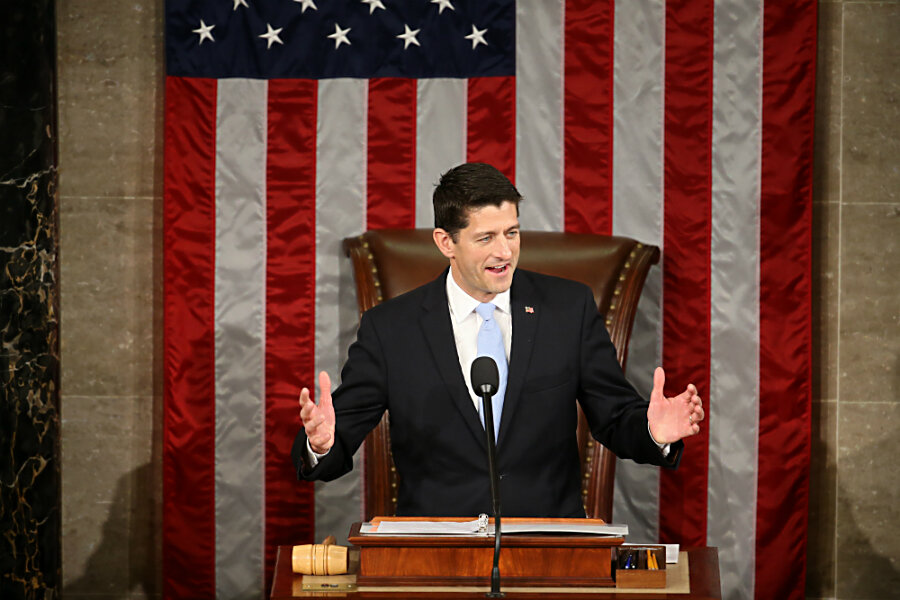Paul Ryan's plan to unify Republicans: 'the vision thing'
Loading...
| Washington
To unify House Republicans and move forward, Paul Ryan is seizing on “the vision thing,” as former President George H.W. Bush once called it.
The new speaker is often referred to as an “ideas man,” and the timing for promoting a vision seems good: Hugely divisive issues such as the budget and debt ceiling were largely cleared away by last week’s two-year budget deal, and next year is an election year – meaning that not much legislative business will get done, leaving more room for messaging.
The next step for the party, Speaker Ryan says, is a common vision.
“We’ve been bold on tactics, but we have been timid on ideas, on policies. That is where we need to go,” the Wisconsin Republican told NBC’s “Meet the Press” on Sunday.
Rallying around “big ideas” will be “unifying,” said Ryan, who also appeared on four other talk shows.
But reaching such consensus will be a huge challenge, even for a strong communicator like Ryan. The hard-line Freedom Caucus is not going away. Neither is the influential blogosphere of right-wing commentators.
“I don’t have any reason to think that the Republican Party will suddenly come together in unity overnight,” says Matthew Green, an expert on the speakership at Catholic University in Washington.
Ryan's two main tasks
Ryan essentially has two main tasks, Professor Green says. He needs to “appease, if not appeal to” the conservatives in his party and in the public. And he needs to “position the Republican conference so that it is helping the party’s presidential nominee.”
Ryan is ready to dig in. “What we really have to do here is rally around a common set of principles, apply them to the problems, and then give the country a bold choice,” he said on Sunday.
No one on the Hill is better positioned to lead that charge than Ryan, say many Republicans. He’s the GOP’s reform guy on budgets, taxes, and – more recently – welfare and poverty.
The former vice presidential candidate is the author of budget proposals that many tea party Republicans ran on. Those proposals reflect his values – shrinking government, expanding opportunity for individuals, and radically reforming entitlement programs, such as turning Medicare into a voucher system.
Ryan is “a thinker,” says Arthur Brooks, president of the American Enterprise Institute, a right-leaning think tank in Washington. As such, he’s “ideally suited” to lead the House, a task that Mr. Brooks likens to turning a corporation around.
“The best way to fail is to do exactly what the last guy did, except do it harder,” says Brooks. “The best way to succeed in a turnaround is to expand the leadership, from one of administration to one of vision.”
That means giving more voice to dissenting views, “because that’s what you do in the marketplace of ideas,” he notes. And this is what Ryan is trying to do. One reason that most members of the Freedom Caucus voted for him as speaker was because he promised to run the House in a more bottom-up, less top-down way.
As a former committee chairman himself, Ryan says he favors handing more power back to the committees and opening up bills to more amendments so the rank and file can have a greater say.
Still, it’s going to be a very heavy lift for the new speaker to unite a fractious bunch.
A peek at the challenges
Ryan told CBS’s “Face the Nation” on Sunday that he thinks Republicans should show Americans what GOP tax reform “looks like” and what a “replacement” to the Affordable Care Act, or Obamacare, looks like. But the previous GOP leadership also tried to unify the conference behind a health-care alternative. Several bills emerged – but Republicans couldn’t find consensus.
Ryan himself tried to get agreement on using corporate tax reform to pay for a long-term highway bill. He couldn't achieve that. And that was just one slice of the tax code.
John Boehner also promised a more open Congress when he became speaker in 2011. He cleaned up ethics problems and handed some power back to committees. But the amendment process remained tightly closed in the Rules Committee, known as the speaker’s committee, in part to keep Democrats from upsetting the apple cart.
Once Ryan gets down to legislation, he’ll discover just how hard it is to keep his conference unified enough to get to 218 votes (the number needed to pass a bill) – and it’s even harder with a more freewheeling, open process, says Sarah Binder, a congressional expert at the Brookings Institution, a left-leaning think tank in Washington.
His first test will be the long-term, expensive highway bill, which is due for a vote in the House this week. There could also be difficulties as budget appropriators try to apportion out the spending levels set in the budget deal. Clashes over "policy riders" to a spending bill could lead to another government shutdown.
“He has a pretty tough challenge ahead of him,” Ms. Binder says. His intentions “are sound,” she says, but it will be very difficult to pass bills with a majority of the majority, as Ryan says he wants to.
The key there, she suggests, is held by the sizable “middle” of the caucus – Republicans who “hope ‘yes’ but vote ‘no.’ ”
She is referring to big compromise bills – such as the recent budget deal – where a majority of Republicans vote against a bill, even though they support it. Their concern is that they will be “primaried” by hard-right candidates at home if they favor compromise.
“Is there something different about Ryan and people wanting to be on his conservative, ideological team that would give some cover to those folks in the middle?... You have to turn those members around,” she says.








